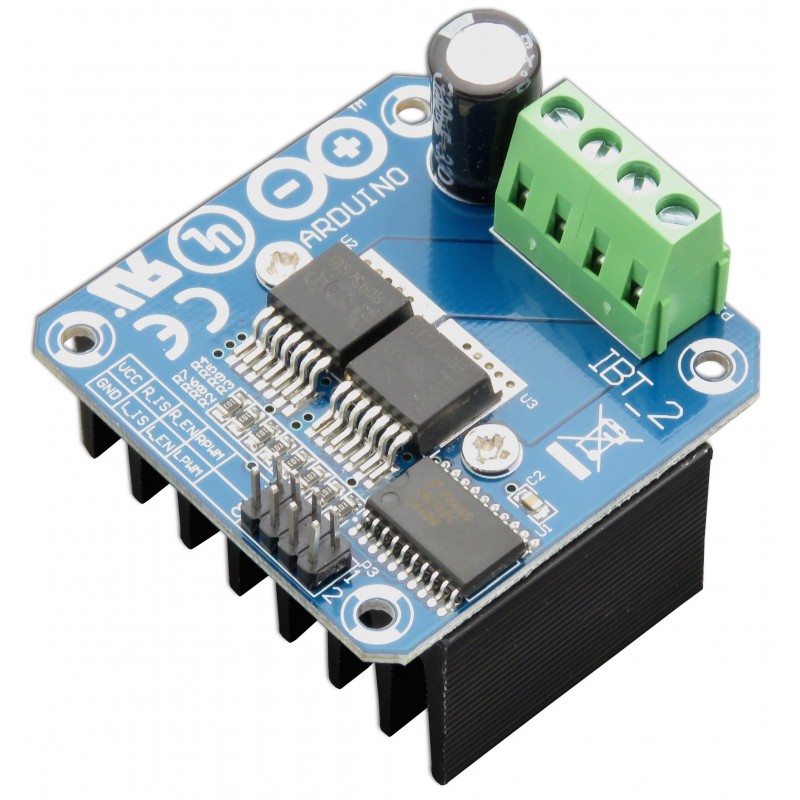





zł31.95 tax excl.
The high power motor driver module works on the basis of Infineon BTS7960B systems. Maximum controller current: 43 A, operating voltage range: 5.5V - 27V. The module has a heat sink and can be controlled from the Arduino, Raspberry Pi, and STM levels. IBT_2
The high power motor controller module allows you to control the motor with a current consumption of up to 43 A. The board has a small size, is equipped with a heat sink and screw connections. H-bridge systems are protected against short-circuit, overload or overheating. The module can be controlled from the level of Arduino, Raspberry Pi, STM. Operating voltage range: 5.5-27 V.
| Contact | Name | Description |
|---|---|---|
| 1 | RPWM | Engine control signal in R direction (PWM or level) |
| 2 | LPWM | Engine control signal in direction L (PWM or level) |
| 3 | RHENIUM | Signal of work permit in the direction of R |
| 4 | FLAX | Work permit signal in the L direction |
| 5 | R_IS | Alarm output (R) |
| 6 | L_IS | Alarm output (L) |
| 7 | VCC | Power input buffer (3.3-5.5 V) |
| 8 | GND | Mass |
Data sheet
Manufacturer BTC Korporacja sp. z o. o. Lwowska 5 05-120 Legionowo Poland sprzedaz@kamami.pl 22 767 36 20
Responsible person BTC Korporacja sp. z o. o. Lwowska 5 05-120 Legionowo Poland sprzedaz@kamami.pl 22 767 36 20
Pololu High-Power Motor Driver 18v25 CS
TB9051FTG Single Brushed The DC Motor Driver Carrier is a single DC motor driver that allows the motor to be supplied with voltage in the 4.5 ... 28V range and power consumption at a continuous 2.6 A (5A peak) operation. Pololu 2997
Dual motor controller allowing two DC motors to be driven with voltages from 4.5 to 13.5V and a continuous current of 1.2 A per channel. SparkFun ROB-14450
DC motor driver that allows you to control the movement of two drives using the I2C interface. Board without connectors. Pololu 5056
No product available!
A single-channel DC motor driver with an I2C interface. It is powered from 4.5 V to 48 V and can deliver up to 2.2 A of current. A board with connectors for mounting. Pololu 5061
No product available!
Module of a 4-channel driver of DC motors with RP2040 microcontroller. It allows the connection of encoders and is equipped with a QW/ST connector. Pimoroni PIM636
Direct current motor driver (DC) with a working voltage from 5 to 30 V and a maximum continuous current of 30 A. It can be controlled by a PWM signal or by means of built-in buttons. Cytron MD30C
No product available!
Gravity: IO Expansion & Motor Driver Shield is an Arduino compatible expansion board that provides digital I / O ports, analog I2C, SPI and UART interfaces, as well as a DC motor driver. DFRobot DFR0502
Module with TB6612FNG DC motors dual driver. The board is equipped with a Grove connector and communicates via the I2C interface. Seeed Studio 108020103
This discrete MOSFET H-bridge motor driver enables bidirectional control of one high-power DC brushed motor. The small 1.3″ × 0.8″ board supports a wide 6.5 V to 30 V voltage range and is efficient enough to deliver a continuous 17 A without a heat sink.
No product available!
DC motor driver module with two channels, dedicated to use in modeling. It can be controlled by an RC transmitter and uses the PPM signal. DFRobot DFR0513
TB6612FNG dual DC motor controller module. It can be used as a stepper motor driver or solenoid driver. Adafruit 2448
DC motor driver that allows you to control the movement of two drives using the I2C interface. Board with connectors for assembly. Pololu 5052
No product available!
This discrete MOSFET H-bridge motor driver enables bidirectional control of one high-power DC brushed motor. The small 1.3×0.8″ board supports a wide 6.5V to 40V voltage range and is efficient enough to deliver a continuous 13A without a heat sink. Driver includes reverse-voltage protection along with basic current sensing and current limiting functionality. Pololu 2992
No product available!
Dual motor controller allowing two DC motors to be driven with voltages from 4.5 to 13.5V and a continuous current of 1.2 A per channel. SparkFun ROB-14451
Two-channel driver for DC motors with an operating voltage from 7 to 35 V and a continuous current up to 10 A. It can be controlled by an analog signal, PWM, UART, RC or by means of built-in buttons. Cytron MDDS10
This shield makes it easy to control two high-power DC motors with your Arduino or Arduino-compatible board. Its twin discrete MOSFET H-bridges support a wide 6.5 V to 30 V operating range and are efficient enough to deliver a continuous 18 A without a heat sink.

The high power motor driver module works on the basis of Infineon BTS7960B systems. Maximum controller current: 43 A, operating voltage range: 5.5V - 27V. The module has a heat sink and can be controlled from the Arduino, Raspberry Pi, and STM levels. IBT_2
